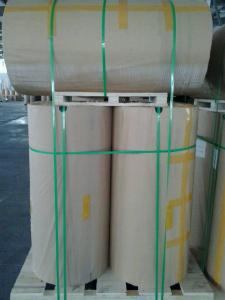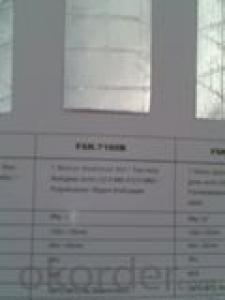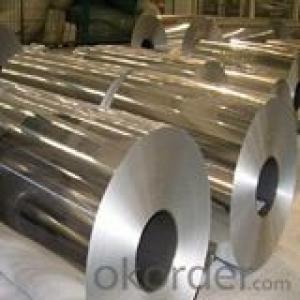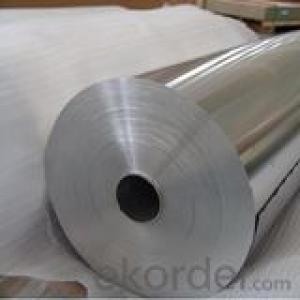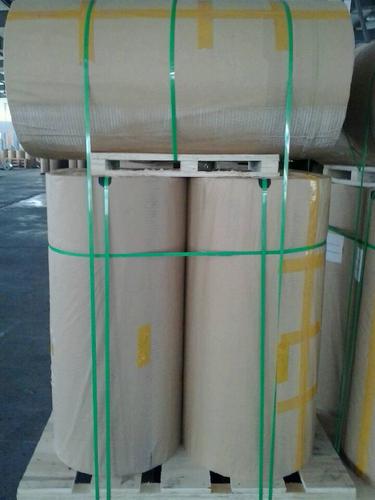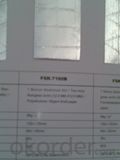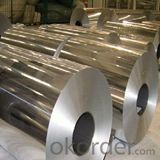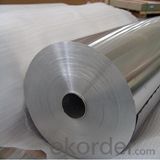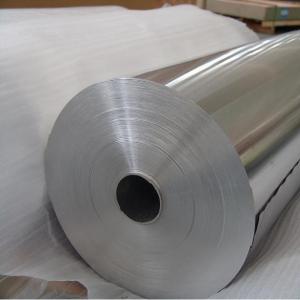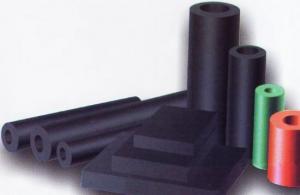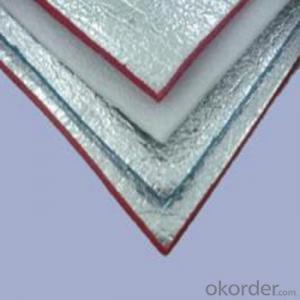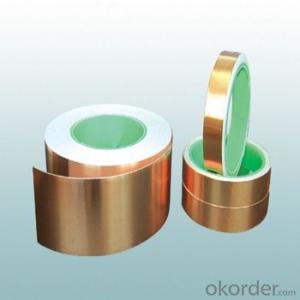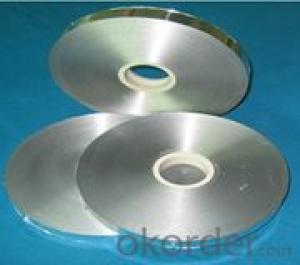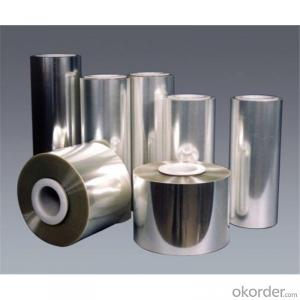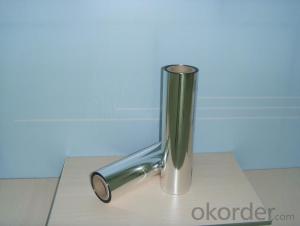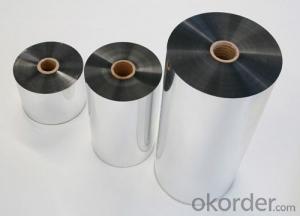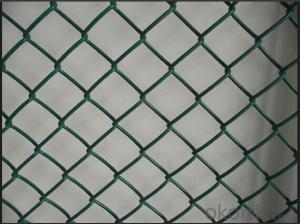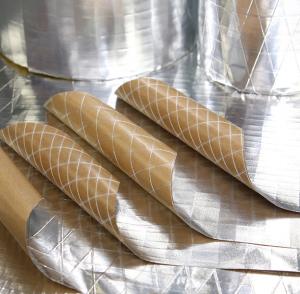Aluminum Foil Facing Bubble Foil Composite Film 7mic Al + 12mic PET
- Loading Port:
- Shanghai
- Payment Terms:
- TT or LC
- Min Order Qty:
- 53 inch
- Supply Capability:
- 35 inch/month
OKorder Service Pledge
OKorder Financial Service
You Might Also Like
1. Aluminum Foil Facing Description:
The production technologies and products performance of aluminum foil facing have been up to international advanced level. The aluminum foil facing products are mainly used for HVAC system, refrigerators, building thermal aluminum foil facing insulation and laminated with glass wool and rock wool to increase the insulation function.
• FSK aluminum foil facing is mainly used for duct wrap in HVAC system and other fields, such as vapor barrier etc., and suitable for off-line lamination of glass wool or rock wool. By special processing, the facing will have excellent flame retardant property.
• Heat-sealing aluminum foil facing is used for duct wrap without applying extra adhesive and suitable for online lamination of glass wool and rock wool.
• The WPSK aluminum foil facing, whose structure is white polypropylene/ fiberglass scrim/ kraft is mainly used for metal building insulation and suitable for the insulation of ware-house, factory, supermarket, office and so on.
• Double sided aluminum foil facing vapor barrier, whose structure is aluminum foil/ high strength kraft /fiberglass scrim /aluminum foil and laminated together by special flame retardant adhesive, can be used for roofing, wall insulation of house, warehouse, cold storages, factory and others.
2.Main Features of the Aluminum foil facing:
• Light weight
• High manufacturing accuracy
• High strength
• Small inertia resistance
• Strong heat dissipation ability
• Good visual effect
• High reflective insulation
• Heat resistant, water proof, stable at high temperature;
• environmentally friendly,no smell and not-toxic;
• Smooth and clear surface;
3.Aluminum Foil Facing Images
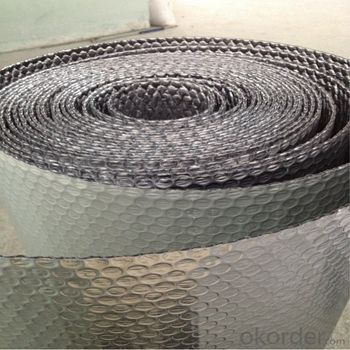
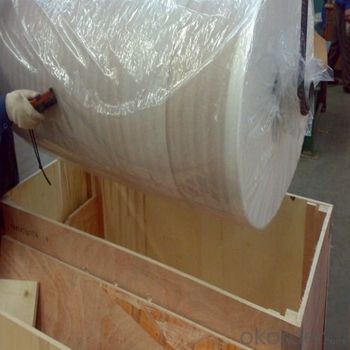
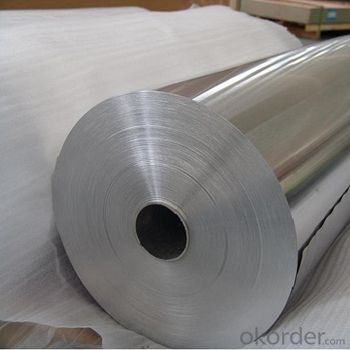
4.Aluminum Foil Facing Specification
TYPICAL PHYSICAL PROPERTIES:
Name:AL+LDPE | |||
Structure | Thickness(mic) | Weight(g/m2) | Yield(m2/kg) |
AL7+ LDPE12 | 21mic | 36 | |
AL7+ LDPE15 | 24 mic | 39 | |
AL9+ LDPE12 | 23mic | 43 | 23 |
AL9 +LDPE15 | 26mic | 48 | 21 |
AL9 +LDPE19 | 30mic | 54 | 19 |
AL9 +LDPE23 | 34mic | 60 | 17 |
AL12 +LDPE12 | 26mic | 52 | 19 |
AL12 +LDPE15 | 29mic | 56 | 18 |
AL12 +LDPE19 | 33mic | 62 | 16 |
AL12 +LDPE23 | 37mic | 67 | 15 |
AL12 +LDPE36 | 50mic | 87 | 12 |
AL15 +LDPE19 | 36mic | 70 | 14 |
AL25 +LDPE12 | 39mic | 87 | 12 |
AL25 +LDPE23 | 50mic | 102 | 10 |
AL40 +LDPE12 | 54mic | 127 | 8 |
AL40 +LDPE15 | 57mic | 131 | 8 |
AL40 +LDPE23 | 65mic | 143 | 7 |
AL40 +LDPE36 | 78mic | 161 | 6 |
AL50 +LDPE12 | 64mic | 154 | 6 |
PROPERTIES | UNIT | VALUE | TEST METHOD |
Basic weight | gsm | 80 | ASTM D646 |
Tensile strength: M. D. X. D. | N/25mm | 95 50 | ASTM C1136 |
Burst strength | N | 25 | ASTM D774 |
Reflectivity of foil surface | % | 95 | ---------- |
Temp. Resistance | -29°C +66°C | No change keep soft | ASTM C1263 |
Water vapor permeance | ng/N.s | 1.15 | ASTM E-96 |
Water Soak Test | 24hrs | No delamination | ---------- |
Width: 1.0m, 1.2m, 1.25 m, 1.30, 1.37m
Length: 200m, 500m, 1000m, 2500m, 2750m, 3300m
Core I.D.: 3"(76mm ±1), 72mm ±1
Based on order, special sizes are also available.
5.FAQ
We have organized several common questions for our clients,may help you sincerely:
(1) How about your company?
A world class manufacturer & supplier of aluminum foil facing and is one of the large-scale professional investment aluminum foil facing bases in China. Annually more than 1000 containers of aluminum foil facing are exported to markets in Europe, America and Japan.
(2)What is the storage condition?
The products should be stored at room temperature and kept from wet and heat source.
It is essential, as with all pressure-sensitive tapes, that the surface to which the tape is applied must be clean, dry, and free of grease and oil.
The user should take test and do trial-application on the above products before coming into application so as to witness and ensure suitability for user’s special purpose and technique.
(3) How to guarantee the quality of the products?
We have established the international advanced quality management system,every link from raw material to final product we have strict quality test;We resolutely put an end to unqualified products flowing into the market. At the same time, we will provide necessary follow-up service assurance.
(4) How long can we receive the product after purchase?
In the purchase of product within four working days, we will arrange the factory delivery as soon as possible. The specific time of receiving is related to the state and position of customers. Commonly 7 to 10 working days can be served
- Q: Is it possible for aluminum foil facing to induce allergic reactions in certain individuals?
- <p>Yes, aluminum foil facing can cause allergic reactions in some people. Aluminum is a common allergen, and individuals with a sensitivity to it may experience contact dermatitis or other allergic responses when exposed to aluminum-containing products. Symptoms can include redness, itching, and rashes. People with a known allergy to aluminum should avoid direct skin contact with aluminum foil and products containing aluminum.</p>
- Q: What are the options available to replace aluminum foil when covering food?
- <p>Yes, there are several alternatives to aluminum foil for covering food. Silicone food covers are reusable, heat-resistant, and can be easily washed. Beeswax wraps are an eco-friendly option, made from natural materials and can be used multiple times. Parchment paper is a disposable option that's ideal for baking and can be used in place of foil. Reusable glass or ceramic lids can be used for dishes that need to be covered while cooking. Lastly, some people opt for reusable metal mesh covers, which are suitable for grilling and baking. Each alternative has its own benefits and is chosen based on the specific needs and preferences of the user.</p>
- Q: This question asks for the steps to prepare aluminum foil for cooking, specifically how to set it up.
- <p>To prepare aluminum foil facing for cooking, first, cut a piece of aluminum foil larger than the cooking surface. Clean the foil to remove any dust or debris. Lightly grease the foil with cooking spray or oil to prevent food from sticking. Fold the edges of the foil up to create a shallow tray, ensuring the sides are high enough to contain any juices. Place the foil on the cooking surface, and you're ready to cook. Always handle the foil with utensils when hot to avoid burns.</p>
- Q: This question asks for a method to clean aluminum foil after cooking to get rid of excess oil.
- <p>To remove excess oil from aluminum foil after cooking, first let the foil cool down to avoid burns. Then, you can use a paper towel or a clean cloth to gently wipe away the oil. For stubborn oil, you can wash the foil with warm soapy water. If you're reusing the foil, make sure it's thoroughly dried before storing to prevent any potential for bacterial growth. Always remember to handle aluminum foil with care as it can be sharp and may tear easily.</p>
- Q: What are the potential health risks associated with cooking food using aluminum foil?
- <p>Cooking with aluminum foil can potentially lead to the leaching of aluminum into the food, which may have health implications. While the body naturally eliminates small amounts of aluminum, excessive intake can be harmful. Aluminum has been linked to neurological disorders, including Alzheimer's disease, although the connection is not definitively proven. It's also important to note that the amount of aluminum that leaches into food during cooking is generally considered to be low. However, for those concerned about aluminum exposure, it's advisable to minimize the use of aluminum foil in cooking, especially for acidic foods which can increase the rate of aluminum leaching.</p>
- Q: Describe the optimal method for utilizing aluminum foil facing in culinary applications.
- <p>The best way to use aluminum foil facing in cooking is to preheat the oven to the desired temperature, then line the baking sheet or roasting pan with a sheet of aluminum foil, shiny side up. This helps prevent food from sticking and makes cleanup easier. When roasting meats or vegetables, you can also wrap them in foil to retain moisture and speed up cooking. Ensure the foil is not touching the heating elements to avoid fire hazards. For grilling, use foil to wrap foods like corn on the cob or to create a makeshift baking sheet for delicate items. Always be cautious with acidic foods as they can react with the aluminum.</p>
- Q: This question asks for a comparison between aluminum foil facing and other types of metal foils, highlighting their differences.
- <p>Aluminum foil facing is distinct from other metal foils due to its specific properties. It is lightweight, highly reflective, and offers excellent heat conductivity, making it ideal for insulation and cooking applications. Unlike other metal foils, aluminum foil is non-toxic and can be safely used in food packaging and preparation. It is also corrosion-resistant and has a lower melting point compared to metals like steel or copper, which affects its usability in various industries. Additionally, aluminum foil is more affordable and widely available than some other metal foils, contributing to its popularity in everyday use.</p>
- Q: What are the various materials used as facings for aluminum foil, and how do they differ from one another?
- <p>Aluminum foil facing materials are used in construction and insulation to provide a barrier against air and moisture. The different types include: 1) Kraft paper facing, which is a strong, absorbent paper used for general purposes; 2) Glassine facing, a thin, glossy paper with good water resistance; 3) PE-coated facing, where a layer of polyethylene is applied for enhanced water resistance; 4) Aluminum foil facing, which is a thin layer of aluminum for superior barrier properties; 5) Silicone-treated glass fabric, offering high-temperature resistance and used in high-performance applications. Each type has unique properties affecting their use in various applications.</p>
- Q: This question asks for methods to store aluminum foil to prevent damage and rusting.
- <p>Aluminum foil is resistant to rusting, but it can still be damaged if not stored properly. To store aluminum foil, keep it in a cool, dry place away from direct sunlight. Use an airtight container or a resealable plastic bag to protect it from moisture and air, which can cause it to oxidize and lose its shine. Avoid stacking heavy items on top of it, as this can cause dents and tears. If you have a large amount, consider using a foil storage box with compartments to keep it organized and protected.</p>
- Q: This question asks for advice on how to use aluminum foil effectively in the kitchen.
- <p>Using aluminum foil efficiently in the kitchen can save time and resources. Here are some tips: 1. Pre-cut and store: Keep a roll of aluminum foil in the kitchen and pre-cut pieces for quick use. 2. Double layer for insulation: Use a double layer for wrapping food to retain heat and keep food warm for longer. 3. Line baking sheets: Line baking sheets with foil to prevent sticking and make cleanup easier. 4. Cover dishes: Use foil to cover dishes in the oven to prevent over-browning. 5. Use for grilling: Wrap vegetables or fish in foil for easy, mess-free grilling. 6. Reuse: Reuse aluminum foil for multiple tasks to minimize waste. 7. Avoid overuse: Use only as much foil as needed to prevent unnecessary waste. 8. Recycle: Always recycle aluminum foil after use to contribute to sustainability.</p>
Send your message to us
Aluminum Foil Facing Bubble Foil Composite Film 7mic Al + 12mic PET
- Loading Port:
- Shanghai
- Payment Terms:
- TT or LC
- Min Order Qty:
- 53 inch
- Supply Capability:
- 35 inch/month
OKorder Service Pledge
OKorder Financial Service
Similar products
Hot products
Hot Searches
Related keywords
